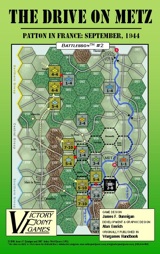The Drive on Metz – Boardgame Review
 The Drive on Metz. Victory Point Games. Designed by Jim Dunnigan. $12.95
The Drive on Metz. Victory Point Games. Designed by Jim Dunnigan. $12.95
Passed Inspection: Simple, quick-playing, inexpensive, high solitaire suitability
Failed Basic: Intended as an introductory wargame, it may be too basic for more experienced players
The Drive on Metz is designed as a primer on strategic wargames.
Overview
On September 7, 1944, a week-long battle between General George S. Patton’s three divisions of the 20th corps faced off against four divisions of the retreating German 1st Army 82nd corps. The American forces had just pushed the Germans across France and were at the end of their supply line. If they could cross the Moselle River and take the vital city of Metz, they could bring a swift end to the war.
Components
The Drive on Metz was designed by James F. Dunnigan and originally published in Wargames Handbook. It is now published as a stand-alone game by Victory Point Games. Before we address the quality of the components, we must first understand the concept behind Victory Point Games. The company is a designed around a collaborative effort between college students and veteran hobbyists. Each game is handcrafted and individually manufactured and assembled. There is a warning that slight imperfections or printing smudges may creep into a product. That being said, the game I received for review was without flaw.
Packaged in a zip-top bag, all the components appear as though they were printed on a home printer, albeit in very high quality, and include an 11”x17” folded-paper map, 40 die-cut 5/7” counters, instruction booklet and sample turn/strategy booklet. All of the items are printed in color. A six-sided die, required for play, is not included.
The map depicts the area west of the Moselle River in Lorraine, France. The scale of 4 kilometers per hex indicates the map is an area 44×36 kilometers. It is filled with important tables and tracking grids such as the Terrain Effects Chart, Combat Results Table and a Game Turn and Victory Point track. The terrain is very basic and includes such things as roads, forests, clearings, rivers and cities. Terrain type affects movement as well as combat effectiveness.
The counters are printed on heavy cardstock and are easy to read. They are labeled with several numbers such as unit type, size and designation, as well as two bold numbers representing Combat Strength and Movement Allowance, separated by a dash. The unit information adds an element of historical flavor to the game, but only the Combat Strength and Movement Allowance are used in gameplay.
The instructions are printed on a large, folded sheet and divided into 10 numbered sections for easy reference. Important information is printed in red, whereas references and examples are printed in blue. The rules are unambiguous, and the game can be learned in a matter of minutes.
Where the components really shine is with the inclusion of a sample turn and strategy booklet. The designer takes the reader through the first two turns and describes the reasoning behind his moves as well as identifying areas that could have been played differently. He also identifies the basic strategies for each side and offers a suggestion for players to help them select a side. He acknowledges that the game has a slight bias towards the German defensive strategy. Several optional rules are then offered.
[continued on next page]
Pages: 1 2

